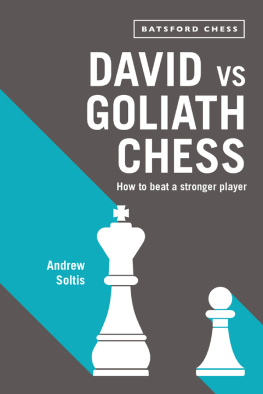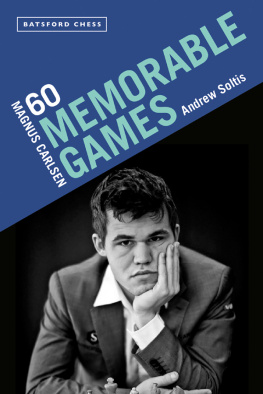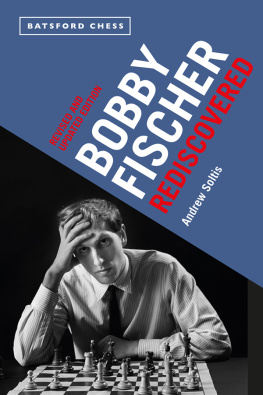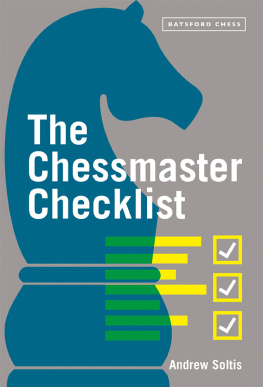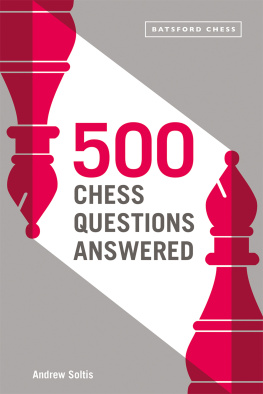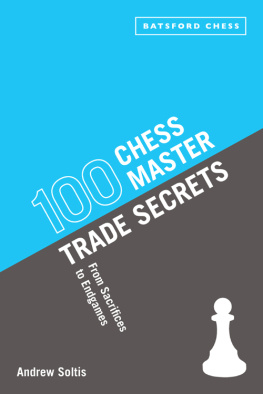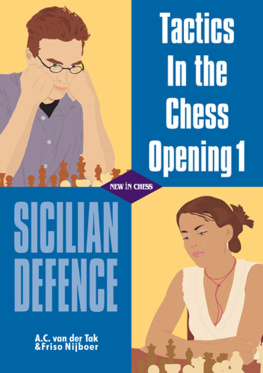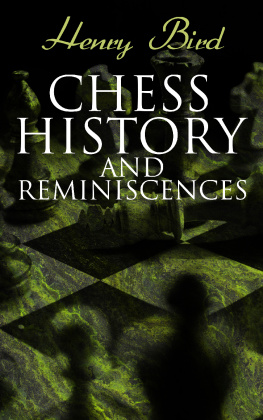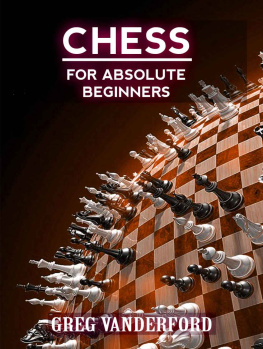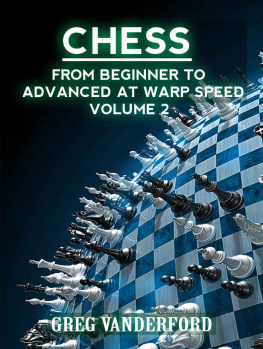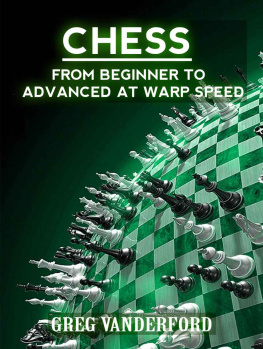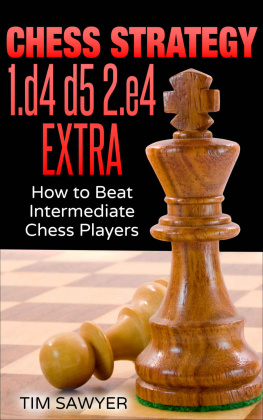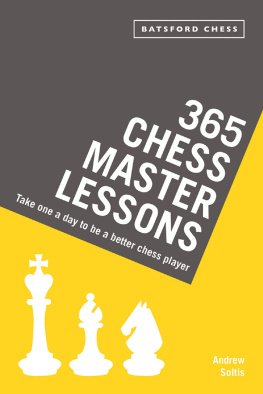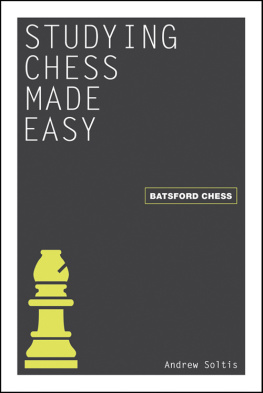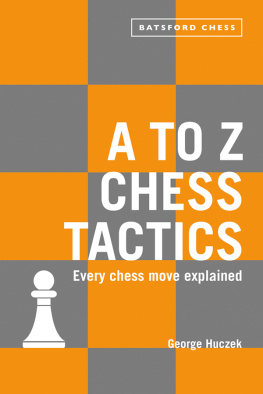Contents
Chapter One:
Its Good To Be A David
Masters are our heroes. Grandmasters are our super-heroes. We honor them and study their games. We respect their strengths, their superior skills.
How can a much lower-rated player, a David, manage to last long against such a Goliath, we wonder?
What we fail to appreciate is that stronger players also have vulnerabilities. They are not vulnerable in spite of their strengths. They are vulnerable because of their strengths:
Goliaths fear draws
A player who outrates his opponent by one class (200 points) should score better than 75 percent. That is, in a four-game match, he would be expected to get at least three points. If the rating difference is a bit more, he should get three wins and only allow one draw, according to the Elo system.
He would be satisfied with that, wouldnt he? No, not at all.
Higher-rateds feel that wins are the natural result when they face much weaker players. Wins should happen. Draws shouldnt. Draws are disappointing.
What this means for a prospective David is that a Goliath wont be content to draw. If the game goes on long enough, he may try to get more out of the position than he deserves.
Or to put it more exactly, more than the position deserves.

Play went 1 ... h3+ 2 g1 h5.
White signaled his willingness to shake hands, with 3 g2.
Black saw nothing better than 3 ... h3+ and White replied 4 g1.
Black was a strong grandmaster. He had once been the worlds third-ranked player and a potential world championship challenger. But in this position he had no reason to refuse the tacit offer of a draw that White has made.
Objectively, the position is even. White is the one who is most likely to open the center favorably with e4-e5.
Black chose 4 ... g7? and quickly went downhill, 5 f1 c8 6 g2 dxe4 7 fxe4 xa6 8 e5!.

Now 8 ... fxe5 9 xa6 xa6 10 xe5 xe5 11 dxe5 would threaten xg5 and d7+ (11 ... b6+ 12 h1 d8 13 xd8 xd8 14 xc6 is a big endgame edge for White). Or 11...f7 12 e6!.
Instead, the game went 8 ... xc5?? 9 exf6+ xf6 10 xe7 xe7 11 xe7. Since 11 ... xe7 12 xg5+ is hopeless, Black played 11 ... f5 and resigned after 12 e5 b1+ 13 e1.
Why did Black reject a draw? He would have readily accepted one against a player who was closer to him in rating. His position didnt tell him to play for a win. His rating did.
Youll find similar examples in this book in which a much higher-rated player loses because of an irrational fear of perpetual check or repetition of the position. But rejecting a tacit or overt draw offer is not the only way that a fear of drawing endangers stronger players:
A Goliath as Black may avoid playing the opening he knows best. Why? Because that opening is designed to equalize against other Goliaths.
For example, he may normally meet 1 e4 with the Petroff Defense or the Berlin Defense of the Ruy Lopez when playing an equal. But those are not high-percentage weapons. Rather, they are Im-happy-to-draw-with-you-today, Fellow-Goliath openings.
So, he may choose to play a Sicilian Defense that he knows less about, just because it is sharper. There are several examples of Sicilian upsets in this book. Similarly, a Goliath may answer 1 d4 with 1 ... d5 against another Goliath. But against a David he will risk a Kings Indian or Benoni Defense and live with the consequences.
In addition, a Goliath may opt for a double-edged middlegame when he would normally head into a slightly favorable endgame. He is abandoning his usual style of play what former world champion Vladimir Kramnik called normal chess.
I should play more normal chess, Kramnik said in a 2015 open tournament where he faced weaker opponents. But somehow I want to win too much every game.
There are other vulnerabilities of higher-rated players:
Goliaths are overconfident
Their success fosters complacency. Complacency breeds carelessness. Carelessness costs.
Take the case of John William Schulten and his battles with Paul Morphy. Schulten was a 19th century American wine merchant who often visited Europe on business. He loved to drop in at chess hangouts and challenge the best players.
His enthusiasm far outran his ability. As a result he became one of the greatest losers in chess history.
Virtually all of his surviving games are defeats and there are likely to be hundreds of other losses that were not recorded. The list of his vanquishers reads like a Whos Who of Romantic-era chess Adolf Anderssen, Johannes Zukertort, Pierre Saint Amant, Ignatz von Kolisch, Lionel Kieseritzky, Bernhard Horwitz, Gustav Neumann and Morphy.
Schulten came to New York in 1857 solely to play Morphy, according to Morphy biographer David Lawson. They contested 24 games over a short period. Morphy won 23. Heres the 24th:
Schulten Morphy
New York 1857
Falkbeer Countergambit C31
1 e4 e5 2 f4 d5 3 exd5 e4 4 c3!?
This was considered a reasonable alternative to 4 d3 at the time.
4 ... f6 5 c4 c6?! 6 d3?! b4
The drawback to 4 c3 is this pin, which can occur in a number of move orders.
7 dxe4 xe4 8 d2 xc3 9 xc3

9 ... 0-0?
Schulten refused to accept material odds so Morphy was playing blindfold. That is, he made his moves without looking at the board. But his moves indicate he chose them without caring about the board. Against a stronger player he would have won with 9 ... h4+ 10 g3 xg3.
10 h5 e8 11 0-0-0 xc3 12 bxc3 a5 13 b2 g6 14 h6 g4? 15 f3 xf3 16 gxf3 b5? 17 f5!

A small miracle has occurred. Now 17 ... d7 18 d3 b4 allows 19 fxg6 fxg6 20 xg6 and wins.
17 ... bxc4?? 18 f6 Black resigned.
Undoubtedly the monotony induced by so many wins accounts for his lapse in a single game, Lawson wrote.
This is far from unique. Some of the worst defeats suffered by the greatest players came about because they just werent concentrating. The following game was played by a world champion during a 33-board simultaneous exhibition.
Capablanca Kevitz
Brooklyn 1924
Orangutan Opening A00
1 b4 d5 2 b2 f5 3 e3 e6 4 f4 f6 5 f3? xb4
Black couldnt take the pawn earlier (4 ... xb4? 5 xg7). Capa apparently just forgot that it was hanging.
6 c3 bd7 7 e2 g4!


